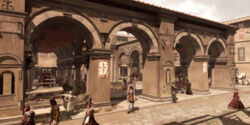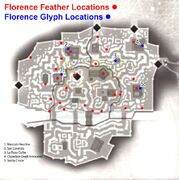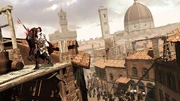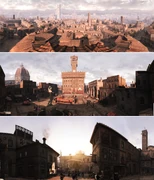Florence (Italian: Firenze) is a major city located in central Italy, and the capital of the region of Tuscany. During the late 15th century, the city was ruled by Lorenzo de' Medici, a member of the powerful Medici family, and housed four districts: Santa Maria Novella, San Giovanni, San Marco, and Oltrarno.
However, the city later fell into a dark age with the Bonfire of the Vanities, when it was under the reign of a tyrannical monk, Girolamo Savonarola.
History
Early development
Florence was founded during the Roman era, in the year 59 BCE, although it would be some 1,400 years before it developed into one of Italy's most important cities. After the sacking of Rome in the 5th century, the Ostrogoths took over. Under their rule, the city was constantly under attack from the Byzantines, who sent the population level below 1,000. However, the Lombards came to power in the 6th century, ending the Byzantine assaults.
Florence grew to a population of 80,000 in the 14th century, of which 25,000 were working in the wool industry. In 1378, a major revolt of the lower class led to the wool combers rising up and seizing the government of the city. Their progressive, radical democracy lasted for less than two months before the upper classes seized control once more, but the revolt so terrified the rich it was still discussed in hushed tones a century later.
The Albizzi family became the de facto rulers after the revolt. Worried about the rise of the Medici family, who were rich bankers rapidly gaining influence in Florence, Maso and Rinaldo Albizzi imprisoned Cosimo de' Medici and exiled him in 1433.
However, Cosimo gained influence behind the scenes, and rose to power in 1434, exiling the entire Albizzi family except for Luca, who had been loyal to Cosimo. Luca Albizzi joined the Signoria, the ruling body of Florence, as Gonfaloniere, succeeding Cosimo's old friend Ilario Auditore in 1442.[1]
Medici rule
After Cosimo de' Medici's revolt, the Medici family governed the city in what would come to be known as its Golden Age; a true Renaissance. The family had a focus on the arts and sciences, as well as an intricate banking system. At the time, the city was also home to some of Italy's most notable figures; including Leonardo da Vinci, Sandro Botticelli, Michelangelo, and Niccolò Machiavelli.[1]
At some point after the year 1291, the Assassin Domenico and his son Renato came to live in Florence, and adopted the name of "Auditore". Under this guise of nobility, they quickly assimilated themselves into the city's upper class, and became a well-respected and known family in Florence.[2]
The city flourished during the reign of Lorenzo de' Medici. Throughout his rule, great artists, philosophers, and others contributed to the city's development. Various architectural marvels blessed the streets of Florence, such as the Santa Maria Novella, the Piazza della Signoria, the Duomo, and the Ponte Vecchio.[1]
Though the Assassin-affiliated Auditore family abandoned Florence after the Pazzi conspiracy in 1476, one of its members, Ezio Auditore da Firenze, continued to frequent the city.[1] During the early 16th century, he would also send his apprentices to Florence to complete several contracts for the Assassin Order; such as delivering reports, stealing weapons, or delivering forged pardons.[3]
Bonfire of the Vanities
After the death of Lorenzo de' Medici in 1492, he was succeeded by his son, Piero. Piero ruled as Signore of Florence until 1494, when he was exiled from the city by Girolamo Savonarola.[4]
Between 1497 and 1498, the monk instigated the Bonfire of the Vanities, where paintings, books, and other fineries were publicly burned throughout Florence. Despite civil unrest, Savonarola held control over the people with both the Apple of Eden, and the terror of his nine lieutenants.[5]
Eventually, in May of 1498, the Assassin Order intervened in his rule. Ezio Auditore tracked down and killed Savonarola's nine lieutenants, while Niccolò Machiavelli, La Volpe, and Paola rallied the citizens. The Florentine people eventually rioted before Savonarola's residence in the Palazzo Pitti, dragging him to the Piazza della Signoria to be burned at the stake.[5]
Modern times
In 2012, Florence was used as a simulated training location by Abstergo Industries during the first and second stage of their Animi Training Program, being introduced to the latter via a system update.
The simulation depicted the Mercato Vecchio, a well-known marketplace in Florence's Santa Maria Novella district, and the surrounding area, which featured lots of narrow alleys, allowing for a quick escape when necessary. Visitors could take a break from the vendors' noisy shouting by reclining on the benches in one of the area's relaxing courtyards. Construction was in progress on some of the rooftops, with hanging platforms having been set up, which allowed people to move easily from the encircling buildings to the Mercato Vecchio itself.
Florence, like most of the simulated locations in the first and second stage, had two aesthetic variations. As such, it could be utilized during the day or the night.
Landmarks
- Santa Maria Novella District
- Mercato Vecchio
- Santa Maria Novella
- Basilica di San Lorenzo

The Mercato Vecchio in Florence
- San Marco District
- San Giovanni District
- Bottega di Leonardo a Firenze
- Piazza della Signoria
- Santa Trinita
- Palazzo Auditore
- Oltrarno District
- Palazzo Pitti
Trivia
- In Assassin's Creed II, the Battistero di San Giovanni was missing from the front of the main entrance to the Santa Maria del Fiore, despite being built several hundred years before the events of the game. Ubisoft explained that the Baptistry's disappearance was due to hardware limitations.
- Florence also appeared in four of Ezio's suppressed Cristina Memories.
- During the Bonfire of the Vanities sequence, the sky over Florence was covered by dark clouds.
Gallery
References
- ↑ 1.0 1.1 1.2 1.3 Assassin's Creed II
- ↑ Assassin's Creed II - Auditore Family Crypt
- ↑ Assassin's Creed: Brotherhood
- ↑ Assassin's Creed: Renaissance
- ↑ 5.0 5.1 Assassin's Creed II - Bonfire of the Vanities (DLC)
| |||||||||||||||||||||||||||||||||||||











